 Your
attic is chock full of all sorts of things, gathered over the years,
that you haven’t used in a long time. Your basement contains more stuff.
There’s not only items that you purchased long ago, but what’s left from
your parent’s house after your mom’s death. Perhaps it’s time to get rid
of those extra items. A yard sale sounds like just the ticket, but where
do you start?
Your
attic is chock full of all sorts of things, gathered over the years,
that you haven’t used in a long time. Your basement contains more stuff.
There’s not only items that you purchased long ago, but what’s left from
your parent’s house after your mom’s death. Perhaps it’s time to get rid
of those extra items. A yard sale sounds like just the ticket, but where
do you start?
A yard sale isn’t as easy as it looks. It takes planning and
organization, especially if you have some worthwhile items to sell. A
yard sale does two things—it allows you to rid of things you no longer
want or use and it allows you make some money. Okay, you won’t get rich,
but you’ll probably make enough to go out to dinner.
Preparing for Your Sale
Begin planning your yard sale a couple months in advance. Start by
setting aside items to sell. But be realistic and discard things you
consider unsaleable. Chipped dishes and glassware, broken china and
pottery, broken appliances, old books, and broken furniture won’t sell.
In fact, adhere to one rule—don’t sell anything that you wouldn’t buy
yourself.
Before you start selling, you should make arrangements to have anything
that doesn’t sell taken away. Arrange in advance for a charity like the
Purple Heart to pick up what you don’t want or plan on taking leftovers
to Goodwill or the Salvation Army.
To find out what things are selling for, visit thrift shops and flea
markets. But remember, in both places, the owner must add in overhead,
something which you won’t have. Also, yard and garage sales are at the
bottom of the retail market. Don’t expect to get what shops charge for
the same item. And don’t look to eBay for prices. Most of them are
inflated, either because of bidding or as a “Buy it now” item.
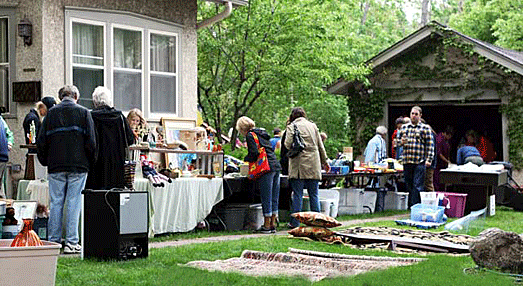
The best place to find out prices at yard and garage
sales is at yard and garage sales. So hop in the car on a Saturday
morning and do some on-site research.
Consider taking more valuable things to consignment or antiques shops.
Even though you’ll have to pay a commission of up to 50 percent, you’ll
still come out ahead. Most yard and garage sale customers are looking
for cheap items. Many regulars have a budget and probably won’t spend
more than $20 the entire morning. For them, going to yard sales is a
cheap form of entertainment.
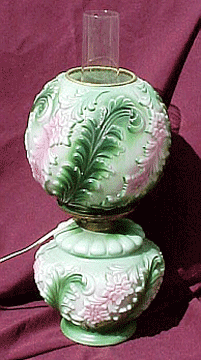 If
you’re selling antiques or collectibles, remember that your customers
are probably Internet savvy and know what things are going for on eBay
and other online auction sites. Antique dealers also use yard and garage
sales to purchase new inventory, so they’re not going to pay what an
item is worth because they need to double the amount to make a profit.
Whatever prices you see for these types of items, halve them.
If
you’re selling antiques or collectibles, remember that your customers
are probably Internet savvy and know what things are going for on eBay
and other online auction sites. Antique dealers also use yard and garage
sales to purchase new inventory, so they’re not going to pay what an
item is worth because they need to double the amount to make a profit.
Whatever prices you see for these types of items, halve them.
And what about getting together with your neighbors and holding a
neighborhood sale? The more the merrier? A neighborhood sale can lure
more buyers, but it also increases competition. But don’t be tempted to
shop your neighbors’ sales and spend more than you’ll make at your own.
Instead of each homeowner working alone, get everyone to work as a team
and divide the advertising, signs, set-up, cleanup and, yes, even coffee
and doughnuts.
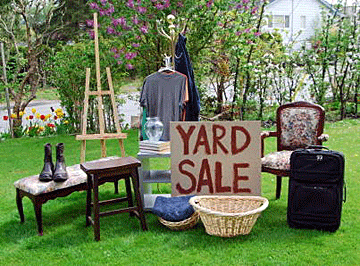 Obviously,
the best time for a yard sale is in the spring or summer. Fall is also
good, as it’s pre-holiday and customers may be looking for small gifts.
Winter sales don’t fare as well. First, then have to be held indoors,
but also the number the customers will be less because people tend to
stay indoors in colder weather. Don’t think that because it’s winter
you’ll have less competition. There’s a reason why there aren’t very
many sales during that season.
Obviously,
the best time for a yard sale is in the spring or summer. Fall is also
good, as it’s pre-holiday and customers may be looking for small gifts.
Winter sales don’t fare as well. First, then have to be held indoors,
but also the number the customers will be less because people tend to
stay indoors in colder weather. Don’t think that because it’s winter
you’ll have less competition. There’s a reason why there aren’t very
many sales during that season.
The best day for your yard sale is Saturday. Some sellers prefer Sunday
and a few with lots of items hold their sales over both days.
Timing is everything: Be warned that dealers and
yard-sale junkies may arrive an hour or two before your start time and
can be aggressive, rifling through unpacked boxes or even walking into
your house.. Stand your ground. Don’t’ let them intimidate you, thinking
that if you don’t sell to the early birds that you won’t sell at all.
The objective is to get rid of stuff, but do so on your terms. Start as
early as 7 A.M. if you want to be the first in your neighborhood. Sales
usually last four to five hours, not counting setup and cleanup. You’ll
need to do all your selling during the morning.
Also, beware of pushy people who show up at your door from Wednesday on.
They read your ad in the local paper and give you a sob story about how
they just can’t get to your sale on Saturday and can they please have a
look. These are usually pickers—people who purchase items at yard or
garage sales and turn around and sell them to local antique dealers the
same day for a hefty profit. Many lie their way in and hassle you until
you give in.
At a yard or garage sale, all sales should be final. And no sale items
should ever go back into your house. Remember, that a charity is coming
for a pickup.
Promotion
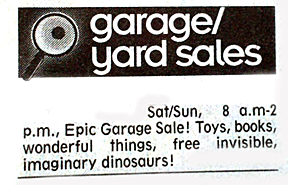 It
used to be that newspaper classified ads were your best promotional
device. But many people have abandoned newspapers for information
online. While you can still take out a small ad in your local paper, you
may find that it alone won’t be enough. List general categories like
antiques or collectibles, housewares and toys, instead of listing
specific items. If people read you have an Arts and Crafts dining table,
they’ll only come to your sale if they want that item. You want as many
customers to attend your sale as possible.
It
used to be that newspaper classified ads were your best promotional
device. But many people have abandoned newspapers for information
online. While you can still take out a small ad in your local paper, you
may find that it alone won’t be enough. List general categories like
antiques or collectibles, housewares and toys, instead of listing
specific items. If people read you have an Arts and Crafts dining table,
they’ll only come to your sale if they want that item. You want as many
customers to attend your sale as possible.
Today, social media is where it’s at. Promote your sale on your Facebook
Page and check the Internet for Web sites where you can post a free ad.
Many towns and cities have a weekly calendar on their site.
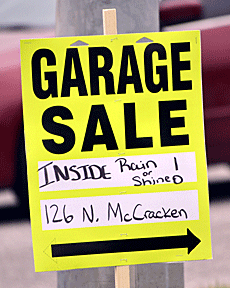 Don’t
forget to put directional signs in your neighborhood at the
intersections of the nearest main road. But check with your town or
township to make sure it isn’t against the law to do so. Use bold
lettering that can easily be read by people in passing cars and don’t
forget to put an arrow pointing toward your home.
Don’t
forget to put directional signs in your neighborhood at the
intersections of the nearest main road. But check with your town or
township to make sure it isn’t against the law to do so. Use bold
lettering that can easily be read by people in passing cars and don’t
forget to put an arrow pointing toward your home.
However you advertise, make sure you give clear directions, especially
if your house is hard to find. Give a rain date or specify ““rain or
shine”” if you can sell from a porch or garage. Add “no early birds” and
“cash only” if you really mean it.
If things are pricey, call it an ““upscale”” or ““estate” sale. If items
are basic and cheap, say so.
Setting Up
Even older items look and sell better if they’ve been cleaned up. Dust
or wash everything. The nicer your items look, the more you can get for
them.
And just as in any retail store, attractive displays sell items. Place
covers over your tables. Old sheets or tablecloths or even remnant
fabric will do. Stick to solid colors or plaids as they will make your
items stand out. If you have a lot of glassware and light-colored china,
use dark fabrics to show them off. Put like items together in tabletop
“vignettes.” to encourage multiple purchases. For instance, place garden
tools with flowerpots, kitchen utensils with cookbooks; kids car seats
with strollers and kids’ furniture.
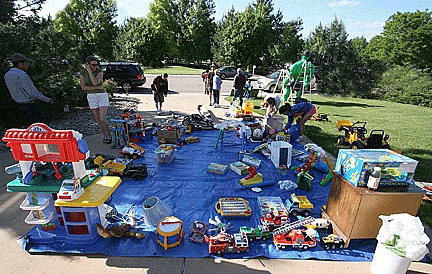 Use
tables for breakables and higher-priced items. In fact, avoid placing
items on a blanket or tarp on the ground. They’re hard for customers to
access. Make it as easy for them as possible. If you’re selling
clothing, buy or borrow a rolling clothes rack and put garments on
hangers. They’ll neater and sell better. If you have large pieces of
furniture that you don’t want to haul outdoors, plan to have someone
escort buyers inside to see them.
Use
tables for breakables and higher-priced items. In fact, avoid placing
items on a blanket or tarp on the ground. They’re hard for customers to
access. Make it as easy for them as possible. If you’re selling
clothing, buy or borrow a rolling clothes rack and put garments on
hangers. They’ll neater and sell better. If you have large pieces of
furniture that you don’t want to haul outdoors, plan to have someone
escort buyers inside to see them.
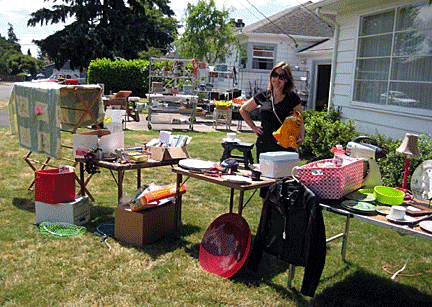 Every
good business has some sort of customer service, and your yard sale
shouldn’t be any different. Have a mirror propped nearby if you’re
selling wearables, as well as a yardstick for measuring things, plus a
plugged-in extension cord or power strip for testing appliances. Start
saving large paper or plastic bags a couple months before your sale and
have a few sturdy boxes and old newspapers for wrapping breakables.
Every
good business has some sort of customer service, and your yard sale
shouldn’t be any different. Have a mirror propped nearby if you’re
selling wearables, as well as a yardstick for measuring things, plus a
plugged-in extension cord or power strip for testing appliances. Start
saving large paper or plastic bags a couple months before your sale and
have a few sturdy boxes and old newspapers for wrapping breakables.
Mark chipped or broken items “as is,” and don’t try to hide flaws with
price tags. And don’t say something works when it doesn’t.
And don’t forget to ask someone to keep an eye on things. Every store
has some sort of security. Put small valuables closest to the person
selling them or the designated cashier. Glass display cases are ideal
for jewelry, silver and other pricey objects. Keep your cash with you at
all times.
Pricing
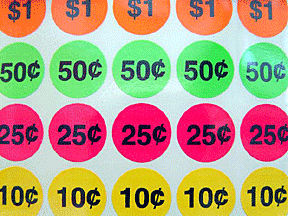 In
order to get the most for your items, price everything. Customers tend
to buy more if they know what the asking price is, especially is they
plan to do some bargaining. Don’t get greedy: Don’t try to charge
retail—even if the item still bears original tags. You’ll be taking a
loss, but you’ll be getting rid of it. Consider offering volume
discounts to avoid piecemeal haggling. Use removable stickers and tags
so as not to damage what you're selling and use index cards to write out
explanations or information about items that may need it.
In
order to get the most for your items, price everything. Customers tend
to buy more if they know what the asking price is, especially is they
plan to do some bargaining. Don’t get greedy: Don’t try to charge
retail—even if the item still bears original tags. You’ll be taking a
loss, but you’ll be getting rid of it. Consider offering volume
discounts to avoid piecemeal haggling. Use removable stickers and tags
so as not to damage what you're selling and use index cards to write out
explanations or information about items that may need it.
Don’t get taken: You don’t have to accept a lower price than you really
want. You can always give things to charity for a tax deduction.
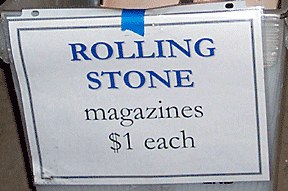 If
you have lots of little miscellaneous items, consider creating box
“lots” by filling various sized boxes with similar items. For example,
put a bunch of small kitchen utensils in a box and sell it for one
price. You can also fill boxes with books----hardbacks in one,
paperbacks in another—and sell them individually out of the box. You can
also create signs for like items, such as “Shoes $5" or “All Stuffed
Animals - $2 each." Some people also provide a box for bargain items.
Create your signs on your computer and place them in plastic sleeves to
protect them from inclement weather.
If
you have lots of little miscellaneous items, consider creating box
“lots” by filling various sized boxes with similar items. For example,
put a bunch of small kitchen utensils in a box and sell it for one
price. You can also fill boxes with books----hardbacks in one,
paperbacks in another—and sell them individually out of the box. You can
also create signs for like items, such as “Shoes $5" or “All Stuffed
Animals - $2 each." Some people also provide a box for bargain items.
Create your signs on your computer and place them in plastic sleeves to
protect them from inclement weather.
If a buyer asks that for an item to held for them due to lack of cash or
need for a larger vehicle, offer to hold it for no longer than an hour,
or request payment up front.
Designate someone as cashier if you won’t be. Make sure you have lots of
change before the sale—ones, fives and tens plus a roll of quarters,
because buyers often come with $20 bills from cash machines.
At the End of Your Sale
Don’t take anything back in. If you can’t get a charity to pick up our
leftovers, look for a book bin to donate books and take anything useful
to a homeless shelter or family-crisis facility. Everything else goes in
the trash bin. Finally, be sure to take down all signs.
< Back to Collecting Archives
Next Article >
